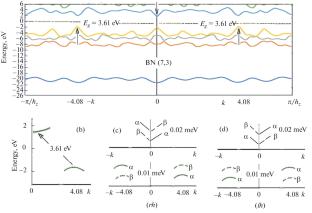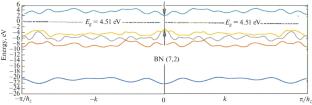手性(7,n2) BN纳米管的自旋性质
IF 1.5
3区 化学
Q3 CHEMISTRY, INORGANIC & NUCLEAR
引用次数: 0
摘要
利用非经验相对论增广柱面波方法,计算了n1 = 7和6≥n2≥1时单壁(n1, n2) BN纳米管的电子结构与手性和自旋的关系。所有纳米管都是宽禁带半导体,光学隙在3.6-4.6 eV之间,价带顶部和导带的自旋轨道分裂最小值为0.15-0.004 meV。右旋和左旋纳米管的自旋分裂能重合,而自旋方向相反。(7,1)纳米管最适合于电子的选择性自旋输运,可以在自旋电子学元件中得到应用。本文章由计算机程序翻译,如有差异,请以英文原文为准。


Spin Properties of Chiral (7, n2) BN Nanotubes
Using the nonempirical relativistic augmented cylindrical wave method, the electronic structure of single-walled (n1, n2) BN nanotubes with n1 = 7 and 6 ≥ n2 ≥ 1 has been calculated as a function of chirality and spin. All nanotubes are wide-bandgap semiconductors with optical gaps within 3.6–4.6 eV and spin–orbit splittings of the valence band top and the conduction band minimum of 0.15–0.004 meV. The spin splitting energies in right- and left-handed nanotubes coincide, and the spin directions are opposite. The (7, 1) nanotube is most suitable for selective spin transport of electrons, which can find application in spintronics elements.
求助全文
通过发布文献求助,成功后即可免费获取论文全文。
去求助
来源期刊

Russian Journal of Inorganic Chemistry
化学-无机化学与核化学
CiteScore
3.10
自引率
38.10%
发文量
237
审稿时长
3 months
期刊介绍:
Russian Journal of Inorganic Chemistry is a monthly periodical that covers the following topics of research: the synthesis and properties of inorganic compounds, coordination compounds, physicochemical analysis of inorganic systems, theoretical inorganic chemistry, physical methods of investigation, chemistry of solutions, inorganic materials, and nanomaterials.
 求助内容:
求助内容: 应助结果提醒方式:
应助结果提醒方式:


